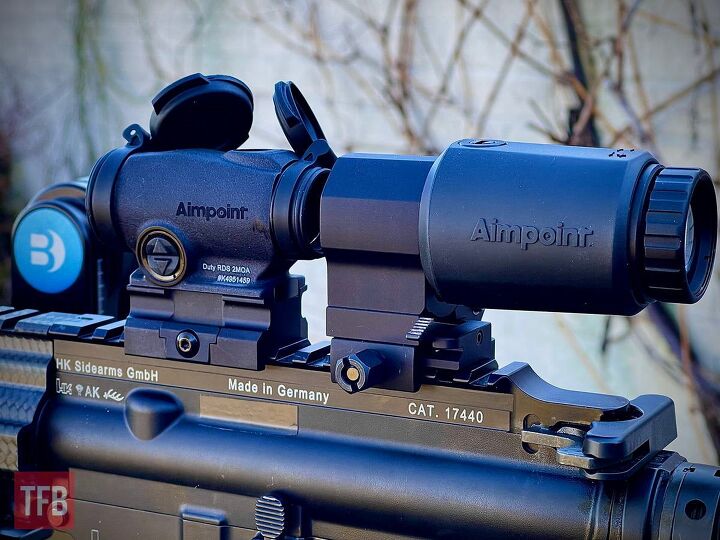This is a review of the Aimpoint Duty RDS with 3X-C Magnifier – 39mm FlipMount & TwistMount base. As a bonus, we added Pulsar’s new PSP-V Adapter to add some thermal capability to the system. Due to the supply and demand situation in the World, it was quite difficult to get our hands on some of these components, but Aimpoint were kind to send me some samples for testing earlier this spring. The Aimpoints have been used on a variety of platforms like the Heckler & Koch MR223, Ruger Precision Rifle and an AR15 in .300 Blackout.
Aimpoint @ TFB:
- TFB Review: The New Aimpoint Acro P-2 Red Dot Sight
- TFB Review: Aimpoint CompM5s Red Dot Sight with Spuhr Mount
- The NEW Aimpoint Duty is Now Available and Shipping
- New Aimpoint Duty RDS Red Dot Sight
Let’s take a quick look at the components:
Aimpoint Duty RDS (Red Dot Sight) – One-piece Torsion Nut Mount, 39mm, comes in at an attractive $499 price. The 2 MOA red dot has 4 night vision compatible settings and 6 daylight settings. You can switch it off as well, but one of Aimpoint’s strengths is the battery life. The Duty RDS is said to give 30,000 hours (that’s over 3 years) of constant operation on setting 7. The weight of the sight (only) is 3.8 oz / 108 grams. If you like to dive, you will appreciate that Aimpoint claims the sight is submersible to 80 feet (25 meters). The intention is that the optics is to be used from short to medium-range target engagements, but obviously, the 3x magnifier described below can help to increase the distance.
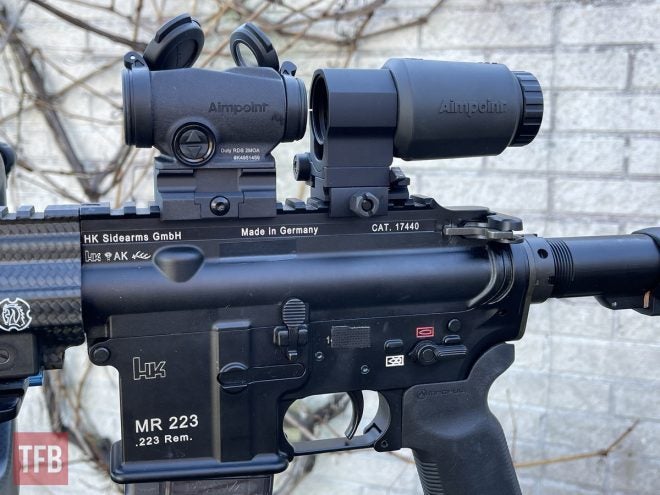
3X-C Magnifier – 39mm FlipMount & TwistMount base is priced at $735 and is compatible with Aimpoint red dot sights (and probably others as well). It’s intended to be used for longer-range aiming or observations. There is a 6x magnifier as well if you don’t find the 3x enough. The optic is submersible to 2 feet (50 cm), which we did not try. You can quickly switch between a 3x magnified optic and 1x if needed. There’s no need for re-zeroing when shifting between non-magnified and magnified aiming but the magnifier will obviously make the 2 MOA dot larger. You can also use it as a handheld observation optic.
So the total price for this Aimpoint red dot and mount is $1,234.
Below: The 3X magnifier with Aimpoint Duty RDS (bottom) and Aimpoint M5b (which I accidentally pointed in the wrong direction).
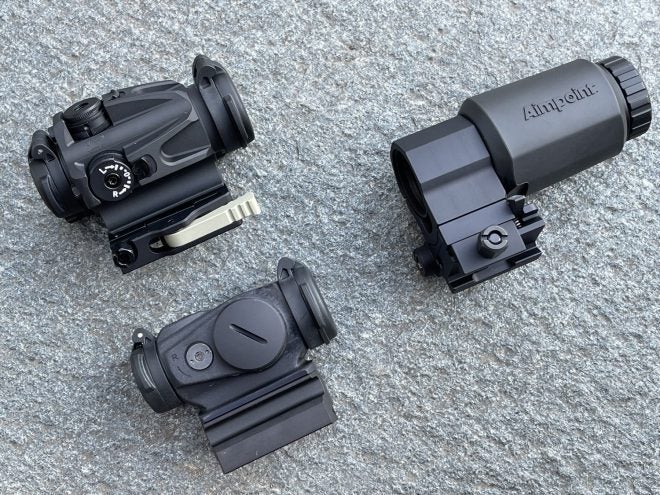
The Aimpoint Duty RDS appears to be of very high quality, just as we normally would expect from this manufacturer. “The Duty” is very compact and kind of appeared to me to be made of polymer, just look at the image below for reference. I was probably fooled by the hard anodized surface finishing, as the production material is pressure forged aluminum. The housing and what’s inside should be able to withstand a lot of abuse.
Below: The windage and elevation adjustments are flush mounted and waterproof. There are no protective caps because they’re not needed. The turrets provide audible “clicks” when you’re zeroing or adjusting the point of impact. A relevant question is how you adjust the point of impact if you don’t have the tools available (far away in a foreign country)? Would it be possible to add an interface for a flat screwdriver or coin?

You can easily manipulate the dot brightness intensity with the rubberized keypad. This works with gloves on as well, and there is a tactile feel to each button press.
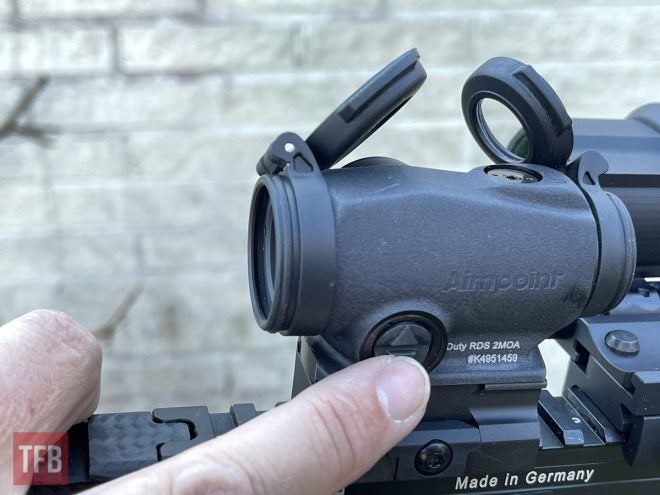
The Duty RDS comes with a one-piece torsion nut mount that attaches to MIL-STD-1913 Picatinny rails. Flip-up lens covers are included and can be removed. They do obscure the field of view in my opinion, so in competition shooting, I would never use them. In “carry” mode it might be more important to keep them to protect the lenses in various situations.

Below: The battery lid hides a single CR2032 battery.
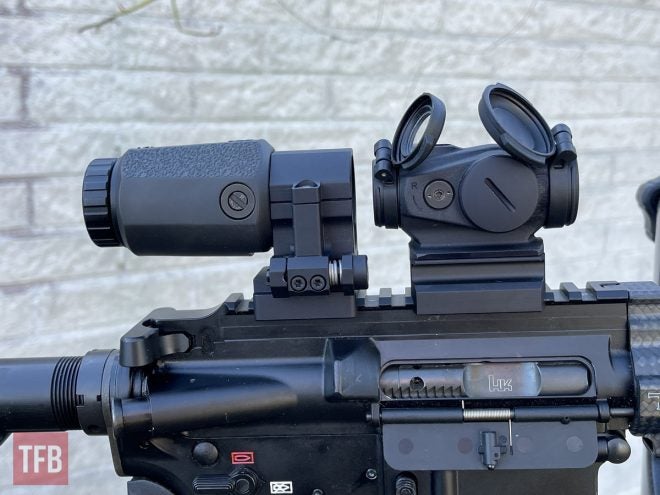

Below: Looking at a tree with the 3x magnifier. It’s always difficult to catch a “true” reticle picture, but we try. However, the camera will expose the image the way it wants, rather than the perfect reference. The dot appears very crisp to me, and I sometimes have difficulties with the dots breaking up. Even when I pushed the dot’s intensity to the top levels it stayed round.

Below: There is the Duty RDS (left/front) and the CompM5b (right) side by side. The CompM5b rides a little lower due to the mount design. The CompM5b Red Dot Reflex Sight – AR15 Ready – comes in at $1,083, but offers ballistic adjustment turrets for distance shooting (among other things). Yes, we’re going to review the CompM5b as well later on.

Below: A closer look.

SAI Suppressed H&K MR223 on a tripod.
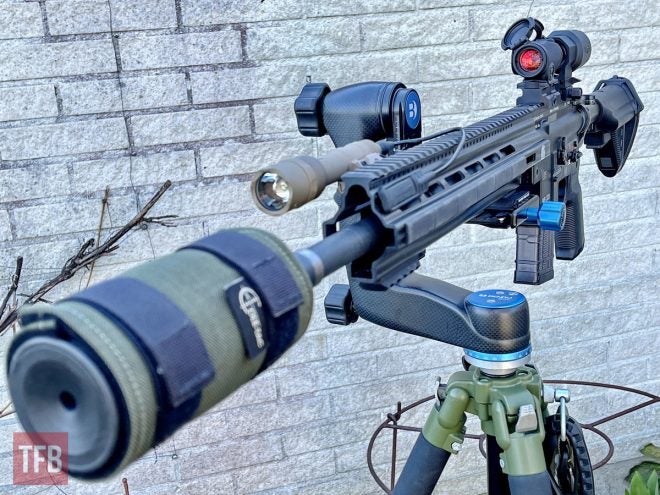
Aimpoint Red Dot – With Thermal Clip-On
And when you thought that was enough, TFB has a surprise for you. We have added the Pulsar PSP-V Adapter to the system, which can carry and place a thermal clip-on in front of the Aimpoint red dot and the magnifier. Yes, the magnifier is definitely needed here otherwise you will not get a good sight picture. I would not recommend using a red dot only with the Pulsar adapter.
You can check TFB’s previous reviews of these Pulsar thermal clip-ons here and here.
Below: The main components, 3x magnifier is missing here.
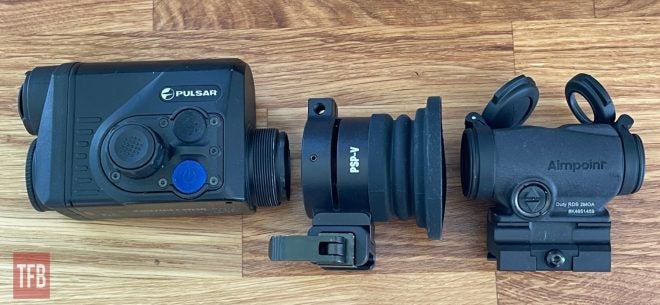
Here’s what is looks like on a Ruger Precision Rifle. Pulsar Proton is the thermal clip-on, to the left in the picture. Some call this a “redneck thermal”, but there’s more to it than that. You could transform your (duty) rifle to thermal or night vision capability within seconds with this setup.
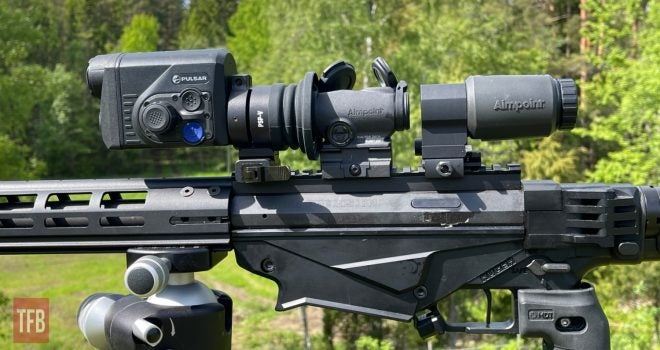
Below: Here is how it appears in the 3xMag. Looking at a telephone pole at about 140 meters. Note the red dot in the middle, it is much more visible in reality.
Note to self: Red hot thermal is perhaps not the best choice when using a red dot, and you want to show others how good it works.
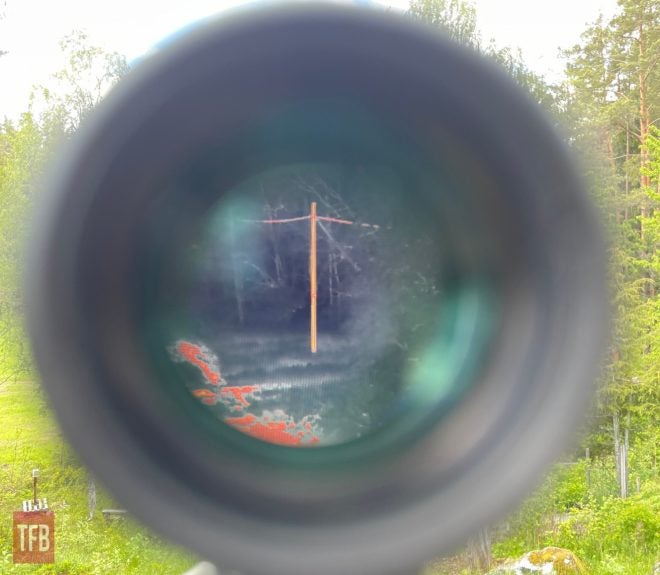
Looking at a tree at about 30 meters, white hot.
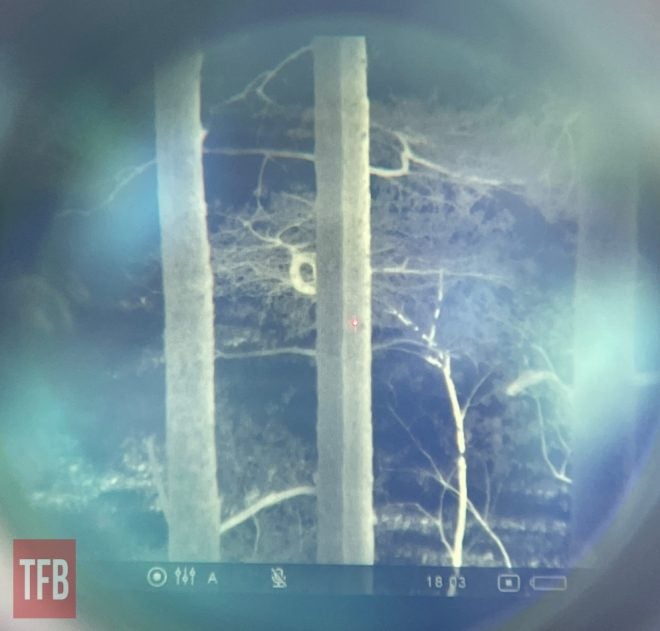
The Ruger isn’t perhaps the best setup for this kind of optics, but it would work great on an AR system. Still, you should be able to get good hits out to 300+ meters, while I would not recommend it for anything but target shooting. It would be difficult to identify the target with the thermal at longer distances.
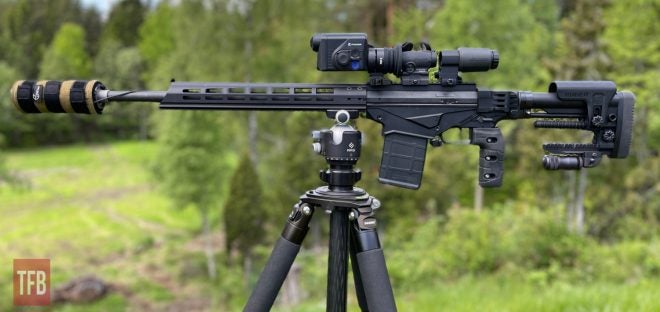
The Aimpoint 3xMag is probably a better optic than you think. There’s very little distortion and the image is very clear all the way to the edges. You can use it as a monocular as well, it works great. There is also a premium version of the 3xMag called 3XMag-1 Magnifier for $1,295. I’m told it’s much better, so I’m really curious what kind of optical improvements there are.
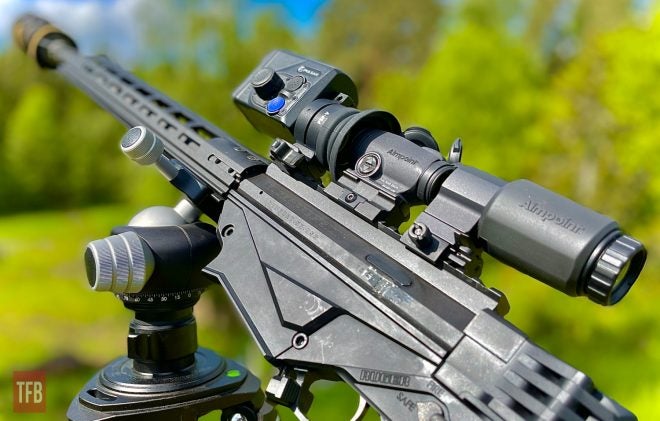
Below: Pulsar’s user interface on the Proton works great.

Below: The same setup, but with a Pulsar Krypton which uses a 640×480 pixels @ 12 µm BAE thermal sensor and a 1746×1000 pixels screen. This is a much more powerful thermal than the Proton.

Below: Looking into the Aimpoint and Krypton, with the magnifier flipped away.

Conclusion
Aimpoint is for sure one of the world’s leading manufacturers of quality red dots. The Duty RDS and the Magnifier are very easy to use, and the red dot burns forever compared to many competitors. Quality-wise, it should outlast a few barrels on your rifle, just make sure you add some Loctite on the screw when you first attach the mount to the Picatinny rail.
The coating on the lens is very neutral, which I like. I couldn’t really spot any color change versus the surroundings at all. On the contrary, I seemed to notice an improvement when looking at some backlit objects, so there might be some anti-reflection Aimpoint Voodoo going on to help you see more details.
With the new Duty RDS, some of the performance of Aimpoint’s high-end optics have been included in a mid-priced product. Priced at $499 it should be an attractive product for law enforcement and security companies looking for a quality optic and mount – “just buy, forget and keep the diode running“. Since the product is available to the public, I’m sure the customer segment is going to be a lot bigger than that.
Whether you need a magnifier or not really depends on how far you want to be able to see. It certainly works well, but I find the price of $735 a bit steep. There is a cheaper version at $499 called 3XMag Magnifier – TwistMount, but I haven’t tried it. There are quite a few Low Power Variable Optics that appear as competitors, but they will have a hard time competing with the durability of an Aimpoint red dot. It’s hard to see anyone regretting buying this setup for their rifle. You could use it just as a simple red dot, or go advanced and use it with Night Vision Goggles or with a thermal clip-on.
You can find Aimpoint USA here: https://aimpoint.us/ and Aimpoint Global here: https://www.aimpoint.com/
We are committed to finding, researching, and recommending the best products. We earn commissions from purchases you make using the retail links in our product reviews. Learn more about how this works.
 Your Privacy Choices
Your Privacy Choices
